Regular expressions (regex) are powerful tools used for pattern matching in strings. When working with text processing, data validation, or even web scraping, regular expressions simplify tasks by offering a concise way to describe patterns. Python’s built-in re module makes working with regex easy and effective. However, mastering regular expressions can be daunting due to their complexity. This article will guide you through how to master regular expressions in Python, covering basic syntax, practical use cases, advanced techniques, and best practices.

Introduction to Regular Expressions
Regular expressions, often abbreviated as regex or regexp, are sequences of characters that define a search pattern. They are primarily used for string matching, which allows you to find, extract, or replace specific parts of text. In Python, regular expressions are implemented through the re module, providing a wide array of functions to work with strings effectively.
Learning how to master regular expressions can significantly improve your ability to work with text-based data. Whether it’s validating user input, extracting specific information from a large dataset, or cleaning up strings, regular expressions provide a flexible and efficient solution.
Why Learn Regular Expressions?
In the world of programming, being proficient with regular expressions is an essential skill for several reasons:
- Efficiency: Regular expressions can significantly reduce the amount of code needed to accomplish string manipulations.
- Versatility: They are supported by most programming languages and can be used in various domains such as web development, data analysis, natural language processing, and automation.
- Power: Regex offers powerful pattern-matching capabilities that go beyond simple string operations.
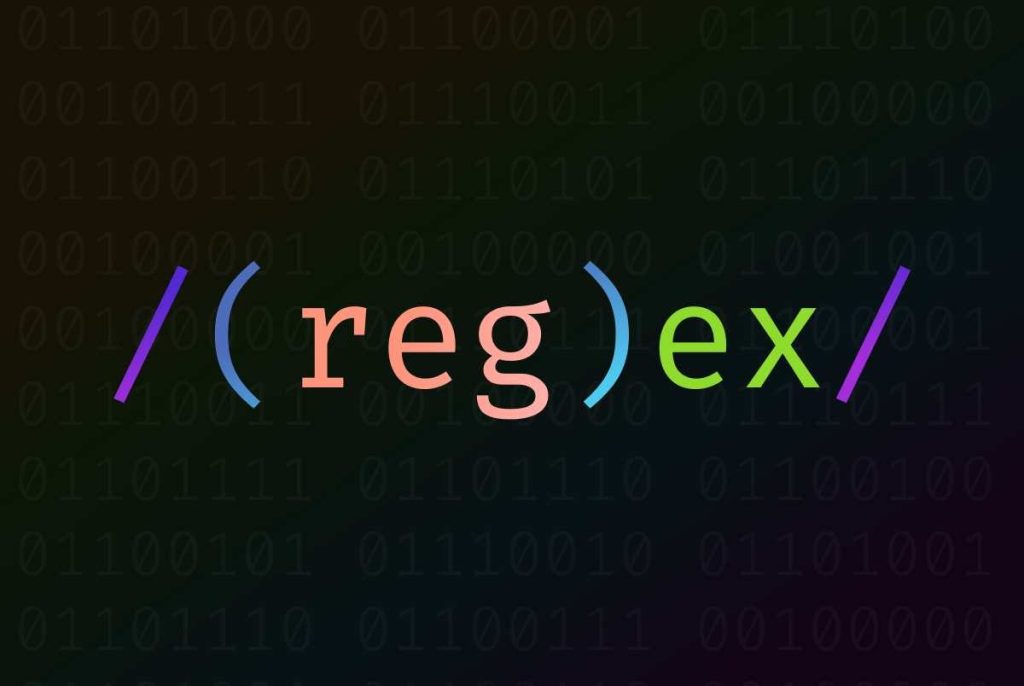
By mastering regex in Python, you will be equipped to handle a variety of tasks, from data cleaning to complex search-and-replace operations.
Installing the re Module in Python
Fortunately, Python comes with the re module built-in, so there’s no need for additional installations. However, to use it in your script, you need to import it at the start of your program:
pythonCopy codeimport re
Once imported, you’re ready to dive into the world of regular expressions.
The Basic Syntax of Regular Expressions
To start with regular expressions in Python, it’s crucial to understand the syntax. Regular expressions are made up of literal characters (like letters and numbers) combined with special characters that define the pattern you want to match.
For example, the expression r"\d" matches any digit, while r"\w" matches any word character (letters, digits, or underscores). Let’s break down some of the most common regex elements:
- Literal Characters: These are regular letters, digits, and symbols. For example, the regex
abcwill match the exact string “abc”. - Meta-characters: Characters like
.,*,?, and+have special meanings and define patterns. For instance,.matches any character except a newline.
Here’s an example to find a simple pattern in a string:
pythonCopy codeimport re
pattern = r"abc"
string = "abcde"
match = re.search(pattern, string)
if match:
print("Pattern found!")
Understanding Meta-characters in Python Regex
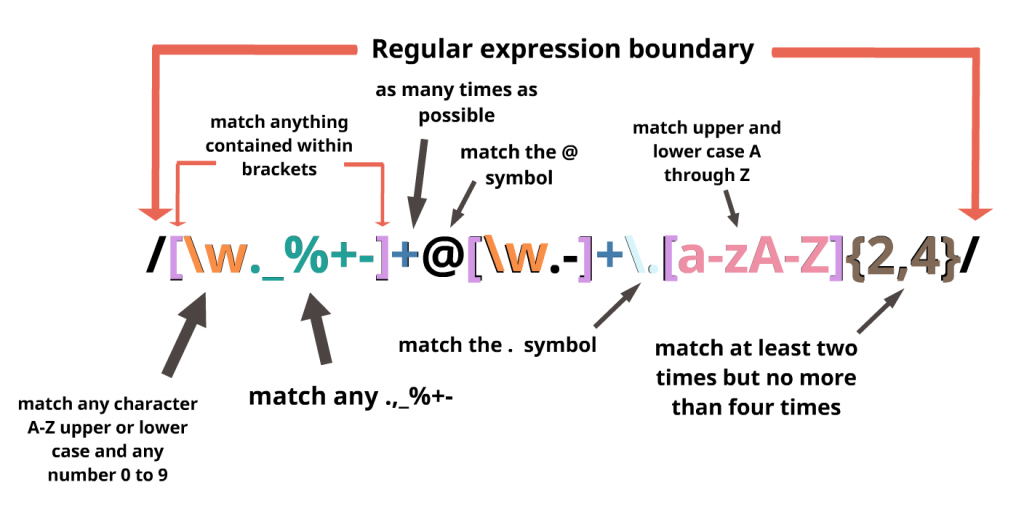
Meta-characters are special characters in regex that have distinct functions. Understanding these is crucial for mastering regex. Some of the most commonly used meta-characters are:
.(Dot): Matches any single character except newline (\n).\d: Matches any digit (0-9).\w: Matches any word character (alphanumeric + underscore).\s: Matches any whitespace character (spaces, tabs, newlines).\b: Matches a word boundary.^: Matches the start of a string.$: Matches the end of a string.
For instance, the pattern r"\d{3}-\d{2}-\d{4}" can be used to match a string formatted as a Social Security number, such as “123-45-6789”.
Anchors in Python Regular Expressions
Anchors are a fundamental part of regex patterns. They do not match characters but rather positions within the string. The two most common anchors are ^ (start of the string) and $ (end of the string).
^: When used at the beginning of a pattern, it ensures that the match must occur at the start of the string.Example:r"^Hello"matches “Hello” only if it appears at the start of the string.$: Used at the end of a pattern, it ensures that the match occurs at the end of the string.Example:r"world$"matches “world” only if it appears at the end of the string.
Combining these anchors with other regex patterns allows for more precise control over where the pattern appears in the string.
Quantifiers: Controlling Repetition in Python Regex
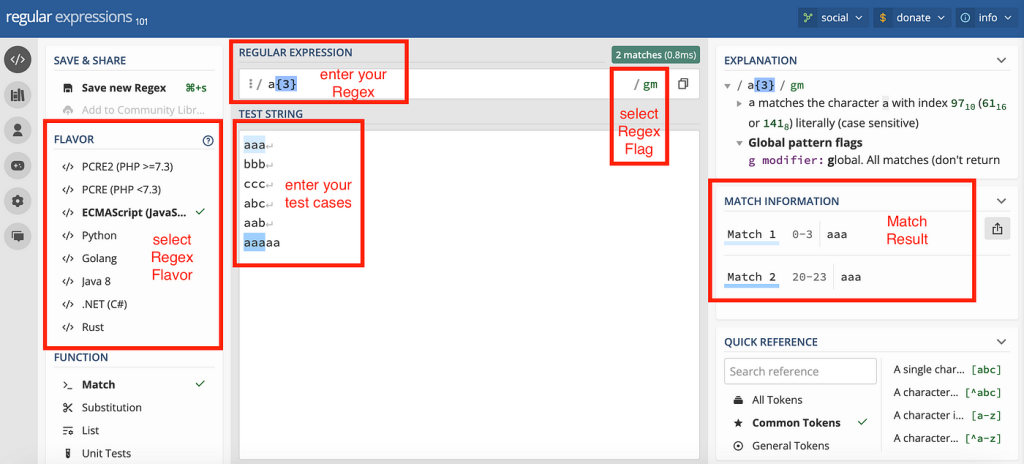
Quantifiers specify how many times an element should occur in a string. In regex, quantifiers can be used to match repeated characters or patterns.
*: Matches 0 or more occurrences of the preceding element.Example:r"ab*"will match “a”, “ab”, “abb”, “abbb”, etc.+: Matches 1 or more occurrences of the preceding element.Example:r"ab+"will match “ab”, “abb”, “abbb”, but not “a”.?: Matches 0 or 1 occurrence of the preceding element.Example:r"ab?"will match “a” or “ab”.{n}: Matches exactlynoccurrences of the preceding element.Example:r"a{3}"will match “aaa”.{n,m}: Matches betweennandmoccurrences of the preceding element.Example:r"a{2,4}"will match “aa”, “aaa”, or “aaaa”.
Quantifiers make it easy to match repeating patterns, whether you need something to occur multiple times or within a range of occurrences.
Working with Character Classes in Python Regex
Character classes (also known as character sets) allow you to define a set of characters that you want to match. They are defined by enclosing characters in square brackets []. Here are some common examples:
[abc]: Matches any one of the charactersa,b, orc.[a-z]: Matches any lowercase letter fromatoz.[0-9]: Matches any digit from0to9.[^abc]: Matches any character that is nota,b, orc.
For example, r"[A-Za-z]" will match any letter, regardless of case.
Using Groups and Capturing in Python Regex
Groups allow you to treat multiple characters as a single unit and capture parts of the matched text. Parentheses () are used to create groups in regular expressions.
For example, if you want to extract the area code from a phone number, you can use grouping:
pythonCopy codeimport re
pattern = r"\((\d{3})\)"
string = "(123) 456-7890"
match = re.search(pattern, string)
if match:
print(match.group(1)) # Outputs: 123
The parentheses not only help to group parts of the pattern but also capture the content of the match, which can be accessed using match.group().
Lookahead and Lookbehind Assertions in Regex
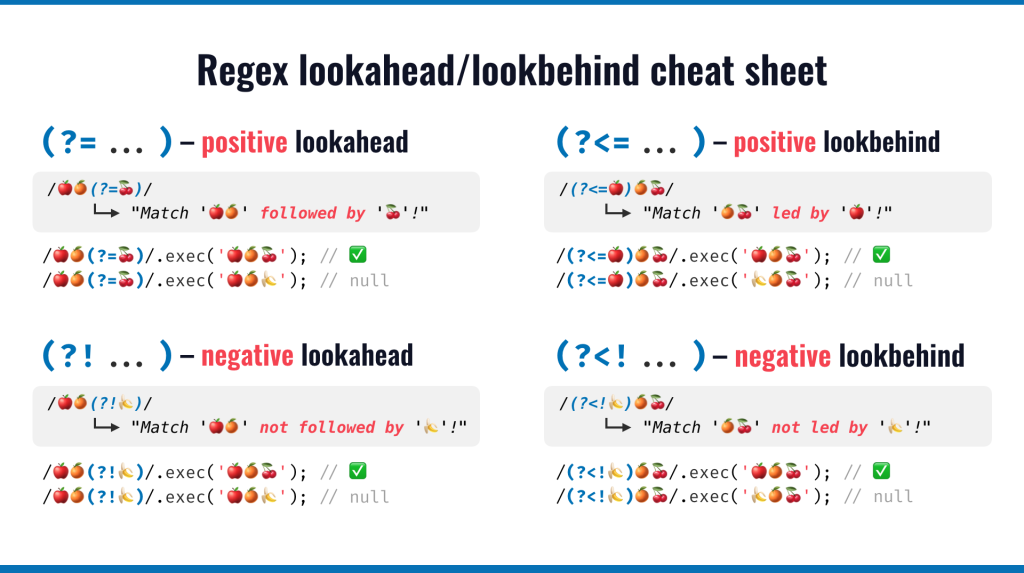
Lookaheads and lookbehinds (collectively known as lookaround assertions) are advanced regex features that allow you to match patterns based on what comes before or after them, without including those characters in the match.
- Positive Lookahead
(?=...): Ensures that a pattern is followed by another pattern.Example:r"\d+(?= dollars)"will match “100” in “100 dollars” but not in “100 euros”. - Negative Lookahead
(?!...): Ensures that a pattern is not followed by another pattern.Example:r"\d+(?! dollars)"will match “100” in “100 euros” but not in “100 dollars”. - Positive Lookbehind
(?<=...): Ensures that a pattern is preceded by another pattern.Example:r"(?<=\$)\d+"will match “100” in “$100”. - Negative Lookbehind
(?<!...): Ensures that a pattern is not preceded by another pattern.Example:r"(?<!\$)\d+"will match “100” in “100 euros” but not in “$100”.
Lookaheads and lookbehinds are incredibly powerful for creating complex, precise matches.
The Power of Alternation in Python Regex
Alternation in regex works like a logical OR and is represented by the pipe character |. It allows you to match one pattern or another.
For example, r"cat|dog" will match either “cat” or “dog”. You can also combine alternation with other regex elements:
pythonCopy codepattern = r"(cat|dog)s?"
This pattern will match “cat”, “cats”, “dog”, or “dogs”.
Escaping Special Characters in Regular Expressions
Since regex uses special characters like . and *, you might need to match these characters literally in some cases. To do this, you can escape the special character with a backslash (\).
For example, to match a literal period (.), you would use r"\.".
pythonCopy codepattern = r"\."
string = "This sentence ends with a period."
match = re.search(pattern, string)
if match:
print("Found a period.")
Practical Use Cases for Python Regular Expressions
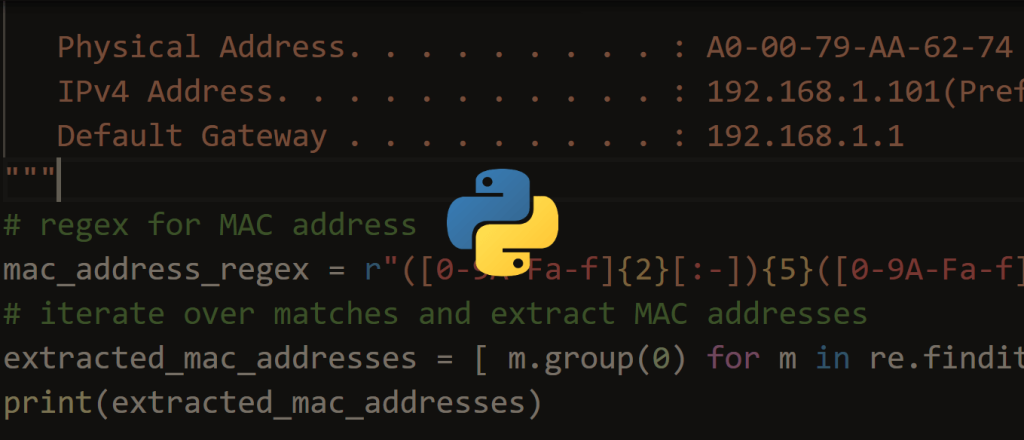
Regular expressions can be used in a wide range of practical applications. Some common examples include:
- Email Validation: Use regex to ensure that an email address is valid.
- Extracting URLs: Use regex to extract URLs from text for web scraping.
- Text Search and Replace: Use regex to search for specific patterns in a text and replace them with something else.
Example: Email Validation
Here’s a simple regex pattern for validating an email address:
pythonCopy codeimport re
pattern = r"^[a-zA-Z0-9_.+-]+@[a-zA-Z0-9-]+\.[a-zA-Z0-9-.]+$"
email = "example@example.com"
match = re.match(pattern, email)
if match:
print("Valid email address")
else:
print("Invalid email address")
This pattern checks that the email follows the general structure of username@domain.com.
Searching for Patterns in Strings
The re.search() function is used to search for a pattern in a string. It returns a match object if the pattern is found and None if not. This function only returns the first match it finds.
pythonCopy codeimport re
pattern = r"hello"
string = "hello world"
match = re.search(pattern, string)
if match:
print("Pattern found!")
Replacing Substrings with re.sub()
The re.sub() function allows you to replace substrings that match a regex pattern with a new string.
pythonCopy codeimport re
pattern = r"world"
string = "hello world"
new_string = re.sub(pattern, "Python", string)
print(new_string) # Outputs: hello Python
This function is particularly useful for text replacement tasks, such as sanitizing user input or formatting strings.
Splitting Strings with Regular Expressions
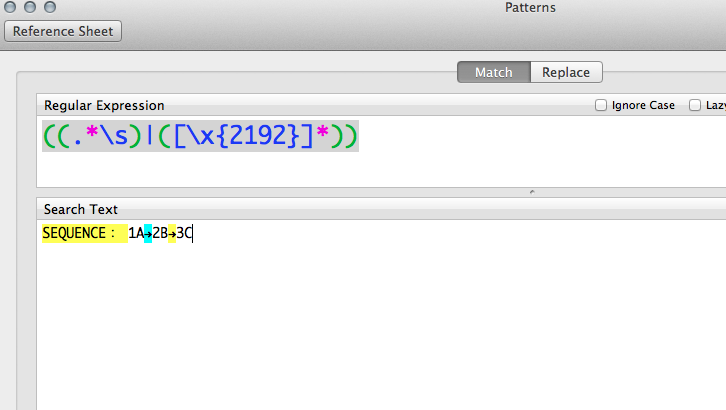
The re.split() function is another powerful tool in Python’s regex arsenal. It allows you to split a string based on a pattern. This is especially useful when you need to break down a string into parts, such as splitting a sentence into words or separating data fields.
Here’s a basic example:
pythonCopy codeimport re
pattern = r"\s+" # Split on one or more spaces
string = "This is a test string"
result = re.split(pattern, string)
print(result)
Output:
cssCopy code['This', 'is', 'a', 'test', 'string']
In this example, the pattern r"\s+" matches one or more whitespace characters, effectively splitting the string by spaces. The result is a list of words.
Advanced Splitting Example
You can also split based on more complex patterns. For instance, if you wanted to split a string by commas but ignore commas inside quotation marks (as in a CSV file), you could use a more advanced regular expression:
pythonCopy codeimport re
pattern = r',(?=(?:[^"]*"[^"]*")*[^"]*$)' # Splits on commas not within quotes
string = 'apple, "banana, berry", orange'
result = re.split(pattern, string)
print(result)
This complex regex ensures that commas within quotes are not used as split points, making it perfect for parsing CSV-like data.
Matching Multiple Patterns with re.findall()
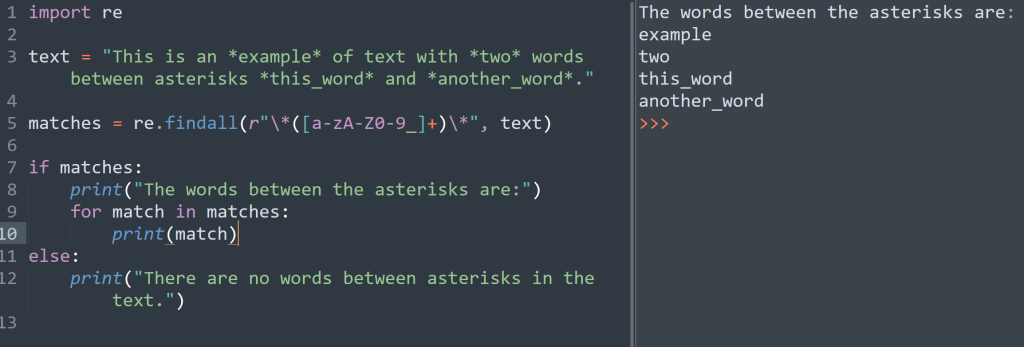
The re.findall() function returns all non-overlapping matches of a pattern in a string, as a list of strings. It’s useful when you need to find multiple occurrences of a pattern.
For example, to extract all the digits from a string:
pythonCopy codeimport re
pattern = r"\d+"
string = "The price is 100 dollars and 50 cents"
matches = re.findall(pattern, string)
print(matches) # Outputs: ['100', '50']
Use Case: Extracting Email Addresses
If you have a large block of text and want to extract all the email addresses, re.findall() is the ideal function:
pythonCopy codeimport re
pattern = r"[a-zA-Z0-9_.+-]+@[a-zA-Z0-9-]+\.[a-zA-Z0-9-.]+"
text = "Contact us at support@example.com and sales@example.org"
emails = re.findall(pattern, text)
print(emails) # Outputs: ['support@example.com', 'sales@example.org']
The pattern matches any valid email addresses within the text and returns them in a list.
Flags in Python Regular Expressions

Flags modify the behavior of regular expressions in Python. They are optional parameters passed to regex functions like re.search(), re.match(), and re.findall(). Some of the most commonly used flags include:
re.IGNORECASE(orre.I): Makes the regex case-insensitive.Example:pythonCopy codeimport re pattern = r"hello" string = "Hello World" match = re.search(pattern, string, re.IGNORECASE) if match: print("Match found")re.DOTALL(orre.S): Allows the dot.to match newline characters as well.Example:pythonCopy codeimport re pattern = r".+" string = "Hello\nWorld" match = re.search(pattern, string, re.DOTALL) if match: print(match.group()) # Outputs: Hello\nWorldre.MULTILINE(orre.M): Makes^and$match the start and end of each line, rather than the start and end of the whole string.Example:pythonCopy codeimport re pattern = r"^world" string = "hello\nworld" match = re.search(pattern, string, re.MULTILINE) if match: print("Match found")
These flags are incredibly useful when working with more complex or multi-line strings.
Handling Unicode Characters in Python Regex
In Python, strings are Unicode by default, meaning you can work with non-ASCII characters in your regular expressions. Python’s re module has support for matching Unicode characters using the \u escape sequence or by using Unicode property escapes.
Example: Matching Unicode Characters
If you’re working with text in multiple languages, such as names with accented characters, you can use the \u syntax for Unicode characters:
pythonCopy codeimport re
pattern = r"\u00E9" # Matches the character "é"
text = "Café"
match = re.search(pattern, text)
if match:
print("Match found")
For more advanced Unicode matching, you can use the \p{} syntax (with third-party libraries like regex instead of re):
pythonCopy codeimport regex as re # `regex` module is different from `re`
pattern = r"\p{L}" # Matches any Unicode letter
text = "Café123"
matches = re.findall(pattern, text)
print(matches) # Outputs: ['C', 'a', 'f', 'é']
This approach allows you to match any letter, regardless of language or script.
Greedy vs. Non-Greedy Matching in Regex
Regex quantifiers like *, +, and ? are “greedy” by default, meaning they try to match as much text as possible. Sometimes, however, you want them to be “non-greedy” (also known as “lazy”) so that they match as little text as possible.

Greedy Matching
A greedy quantifier will match the longest possible string that satisfies the pattern:
pythonCopy codeimport re
pattern = r"<.*>"
text = "<html><body></body></html>"
match = re.search(pattern, text)
print(match.group()) # Outputs: <html><body></body></html>
In this case, the .* quantifier matches everything between the first < and the last >, which is often not what you want.
Non-Greedy Matching
To make a quantifier non-greedy, you add a ? after it. This will make the pattern match the shortest string possible:
pythonCopy codeimport re
pattern = r"<.*?>"
text = "<html><body></body></html>"
match = re.search(pattern, text)
print(match.group()) # Outputs: <html>
The .*? quantifier matches as little as possible, stopping at the first closing >.
Debugging Regular Expressions in Python
Regular expressions can get complicated quickly, and debugging them can be challenging. Fortunately, there are several strategies and tools you can use to troubleshoot your regex patterns:
- Use Online Regex Testers: Websites like regex101 and RegExr allow you to test your regular expressions interactively. These tools also provide detailed explanations of the patterns you’re using.
- Verbose Mode (
re.VERBOSE): Python allows you to write more readable regular expressions by ignoring whitespace and comments when there.VERBOSEflag is enabled. This can help you break down complex regex patterns.Example:pythonCopy codeimport re pattern = re.compile(r""" \d{3} # Area code - # Separator \d{3} # First 3 digits - # Separator \d{4} # Last 4 digits """, re.VERBOSE) match = re.search(pattern, "123-456-7890") if match: print("Match found") - Use
re.debug(): Python’sremodule also has a debug mode that can be turned on to see detailed explanations of how the regex engine is processing your patterns.
Common Pitfalls When Using Regular Expressions

Regular expressions are powerful but can also lead to confusion if used incorrectly. Here are some common pitfalls to watch out for:
- Greedy vs. Non-Greedy Matching: As mentioned earlier, greedy quantifiers may match more text than you expect. Be cautious when using
*,+, and?without understanding how they work in different contexts. - Overusing Regular Expressions: While regex is highly useful, it’s not always the best solution. For simple tasks, basic string methods like
str.find(),str.split(), andstr.replace()might be faster and more readable. - Forgetting to Escape Special Characters: If you’re trying to match a special character (like
.or*), remember to escape it with a backslash (\). Otherwise, it will be interpreted as part of the regex syntax. - Poor Readability: Complex regular expressions can become unreadable quickly. Using the
re.VERBOSEmode and breaking down patterns with comments can make them easier to understand and maintain.
Optimizing Regex Performance in Python
Regular expressions can be computationally expensive, especially when used with complex patterns or large data sets. Here are some tips for optimizing regex performance:
- Use Non-Capturing Groups: Capturing groups (those surrounded by parentheses) store matches, which can slow down performance. If you don’t need to capture the match, use non-capturing groups instead:
(?:...). - Avoid Backtracking: Certain patterns, like nested quantifiers (e.g.,
(.+)*), can cause the regex engine to perform excessive backtracking, which drastically reduces performance. Simplify patterns to avoid this issue. - Pre-Compile Patterns: If you’re using the same pattern multiple times, compile it once using
re.compile()and reuse it. This can reduce the overhead of re-compiling the pattern each time. - Profile Your Regex: Use Python’s
timeitmodule or similar profiling tools to measure the performance of your regular expressions and optimize where necessary.
Using Regular Expressions for Data Validation
One of the most common uses of regular expressions is validating user input, such as email addresses, phone numbers, and dates. Regex allows you to enforce strict rules for input validation while keeping your code concise.

Example: Validating a Phone Number
Here’s a regex pattern for validating a phone number in the format (123) 456-7890:
pythonCopy codeimport re
pattern = r"^\(\d{3}\) \d{3}-\d{4}$"
phone = "(123) 456-7890"
if re.match(pattern, phone):
print("Valid phone number")
else:
print("Invalid phone number")
This pattern ensures that the phone number follows the exact format, with three digits enclosed in parentheses, followed by a space, three more digits, a hyphen, and four digits.
Regex for Web Scraping in Python
Regular expressions are invaluable tools for web scraping, where you often need to extract specific information from HTML or other structured text. While libraries like BeautifulSoup and Scrapy are more robust for full-scale web scraping, regex can be useful for quick tasks or when scraping text-heavy content.
Example: Extracting Links from HTML
Here’s a simple regex pattern for extracting URLs from an HTML document:
pythonCopy codeimport re
html = '<a href="http://example.com">Example</a> <a href="https://example.org">Example Org</a>'
pattern = r'href="(https?://[^"]+)"'
links = re.findall(pattern, html)
print(links) # Outputs: ['http://example.com', 'https://example.org']
This pattern matches any URL that starts with http:// or https:// and is enclosed in an href attribute.
Writing Readable Regular Expressions
Readability is key when writing regex patterns, especially when working in teams or on large projects. Here are a few tips to ensure your regular expressions remain understandable:

- Use Comments: In
re.VERBOSEmode, you can add comments to break down your regex into more understandable chunks. - Break It Down: If your regex is too long, consider splitting it into smaller parts and combining them using concatenation.
- Test Your Regex: Always test your regex on a variety of inputs to ensure that it behaves as expected. This is particularly important for complex patterns.
Testing Regular Expressions in Python
Testing your regular expressions thoroughly ensures that they handle both typical and edge cases correctly. Here are a few approaches to testing your regex:
- Unit Tests: Write unit tests to check that your regular expressions work as intended for a range of inputs.
- Online Testers: Use tools like regex101 to experiment with different patterns and understand how they match various inputs.
- Edge Cases: Test your regex with unusual or unexpected inputs to ensure it doesn’t break. For example, if you’re validating email addresses, test with addresses that have unusual but valid formats, such as “user+name@example.co.uk“.
Advanced Regular Expression Techniques
As you become more comfortable with regular expressions, you’ll want to explore advanced techniques to solve complex problems. Some of these techniques include:
- Recursive Patterns: In some regex engines (not Python’s
remodule), you can use recursive patterns to match nested structures like parentheses or HTML tags. - Named Groups: Use named groups to make your regex matches more readable and accessible.Example:pythonCopy code
import re pattern = r"(?P<area_code>\d{3})-(?P<phone_number>\d{7})" match = re.search(pattern, "123-4567890") if match: print(match.group("area_code")) # Outputs: 123
Named groups allow you to refer to specific parts of the match by name rather than by index, which can make your regex much easier to understand and maintain.
Summary and Conclusion
Mastering regular expressions in Python is a critical skill for anyone involved in data processing, text analysis, or web scraping. Regular expressions offer a concise and powerful way to match patterns, manipulate strings, and extract valuable information from text.
By understanding the basic syntax, meta-characters, quantifiers, and advanced techniques like lookaheads and lookbehinds, you can build sophisticated patterns that handle a wide range of tasks. Remember to test and optimize your regular expressions to ensure they perform efficiently and accurately.
With this guide, you now have the foundational knowledge to master regular expressions in Python and apply them to real-world projects, whether for data validation, text search and replace, or more complex string operations.
FAQs
What is the re module in Python used for?
The re module in Python is used to work with regular expressions. It provides functions for searching, matching, and manipulating strings based on regex patterns.
How do I make a regex pattern case-insensitive in Python?
You can make a regex pattern case-insensitive by passing the re.IGNORECASE (or re.I) flag when calling regex functions like re.search() or re.match().
What are greedy and non-greedy quantifiers in regular expressions?
Greedy quantifiers match as much text as possible, while non-greedy (lazy) quantifiers match as little as possible. You can make a quantifier non-greedy by adding a ? after it, such as .*?.
Can I use regular expressions to validate input in Python?
Yes, regular expressions are commonly used to validate input, such as email addresses, phone numbers, or postal codes, by ensuring they follow specific patterns.
How do I test a regular expression in Python?
You can test a regular expression using Python’s re functions like re.search() and re.match(). Additionally, online regex testing tools like regex101 can help you experiment with and debug patterns.
What is the difference between re.match() and re.search() in Python?re.match() checks for a pattern match only at the beginning of a string, while re.search() looks for a match anywhere in the string.


